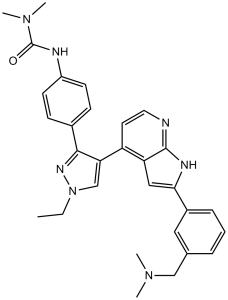GSK1070916 (NMI900 or GSK1070916 A)
This product is for research use only, not for human use. We do not sell to patients.

For small sizes, please check our retail website as below: www.invivochem.com
| Size | Price | Stock |
|---|---|---|
| 250mg | $1050 | Check With Us |
| 500mg | $1620 | Check With Us |
| 1g | $2430 | Check With Us |
Cat #: V0355 CAS #: 942918-07-2 Purity ≥ 98%
Description: GSK1070916 (also known as NMI-900 or GSK-1070916A) is a novel, potent, reversible and ATP-competitive inhibitor of Aurora B/C with potential antitumor activity.
Top Publications Citing Invivochem Products
Publications Citing InvivoChem Products
Product Promise

- Physicochemical and Storage Information
- Protocol
- Related Biological Data
- Stock Solution Preparation
- Quality Control Documentation
| Molecular Weight (MW) | 507.63 |
|---|---|
| Molecular Formula | C30H33N7O |
| CAS No. | 942918-07-2 |
| Storage | -20℃ for 3 years in powder formr |
| -80℃ for 2 years in solvent | |
| Solubility In Vitro | DMSO: 102 mg/mL (200.9 mM)r |
| Water: <1 mg/mLr | |
| Ethanol: N/a | |
| Solubility In Vivo | 2% Cremophor EL, 2% N,N-dimethylacetamide, pH 5.0: ~30 mg/mL |
| SMILES Code | O=C(NC1=CC=C(C2=NN(CC)C=C2C3=C4C(NC(C5=CC=CC(CN(C)C)=C5)=C4)=NC=C3)C=C1)N(C)C |
| Synonyms | GSK-1070916A; GSK 1070916A; GSK1070916A; GSK-1070916; GSK 1070916; GSK1070916; NMI 900; NMI900; NMI-900 |
| Protocol | In Vitro | GSK-1070916 potently inhibits Aurora B/INCENP and Aurora C/INCENP kinases with Kis of 0.38±0.29 and 1.45±0.35 nM, respectively, but is less potent against Aurora A/ TPX2 with a Ki of 492±61 nM. GSK-1070916 also inhibits FLT1, TIE2, SIK, FLT4, and FGFR1 with IC50 values of 42, 59, 70, 74, and 78 nM, respectively. Treatment of A549 human lung cancer cells with GSK-1070916 results in a potent antiproliferative effect (EC50=7 nM). |
|---|---|---|
| In Vivo | In nude mice implanted with human colon tumor (HCT116) xenografts, a single dose of GSK-1070916 administered i.p. inhibits HH3-S10 phosphorylation in a dose-dependent manner. Repeated i.p. administration of GSK-1070916 produces complete or partial antitumor activity in 4 of 8 tumor types [lung, A549; colon, HCT116; acute myelogenous leukemia (AML), HL60; and chronic myelogenous leukemia, K562], stable disease in 3 of 8 (colon, Colo205; lung, H460; and breast, MCF-7), and tumor growth delay in 1 of 8 tumor types (colon, SW620). Daily administration of GSK-1070916 is generally well-tolerated. |
These protocols are for reference only. InvivoChem does not
independently validate these methods.
| Solvent volume to be added | Mass (the weight of a compound) | |||
|---|---|---|---|---|
| Mother liquor concentration | 1mg | 5mg | 10mg | 20mg |
| 1mM | 1.9699 mL | 9.8497 mL | 19.6994 mL | 39.3988 mL |
| 5mM | 0.3940 mL | 1.9699 mL | 3.9399 mL | 7.8798 mL |
| 10mM | 0.1970 mL | 0.9850 mL | 1.9699 mL | 3.9399 mL |
| 20mM | 0.0985 mL | 0.4925 mL | 0.9850 mL | 1.9699 mL |
The molarity calculator equation
Mass(g) = Concentration(mol/L) × Volume(L) × Molecular Weight(g/mol)
Mass
=
Concentration
×
Volume
×
Molecular Weight*
The dilution calculator equation
Concentration(start)
×
Volume(start)
=
Concentration(final)
×
Volume(final)
This equation is commonly abbreviated as: C1 V1 = C2 V2
Concentration(start)
C1
×
Volume(start)
V1
=
Concentration(final)
C2
×
Volume(final)
V2
Step One: Enter information below
Dosage mg/kg
Average weight of animals g
Dosing volume per animal µL
Number of animals
Step Two: Enter the in vivo formulation
%DMSO
+
%
+
%Tween 80
+
%ddH2O
Calculation Results:
Working concentration:
mg/ml;
Method for preparing DMSO master liquid:
mg
drug pre-dissolved in
µL
DMSO(Master liquid concentration
mg/mL)
,Please contact us first if the concentration exceeds the DMSO solubility of the batch of drug.
Method for preparing in vivo formulation:
Take
µL
DMSO master liquid, next add
µL
PEG300, mix and clarify, next add
µL
Tween 80,mix and clarify, next add
µL
ddH2O,mix and clarify.
Note:
- (1) Please be sure that the solution is clear before the addition of next solvent. Dissolution methods like vortex, ultrasound or warming and heat may be used to aid dissolving.
- (2) Be sure to add the solvent(s) in order.




































